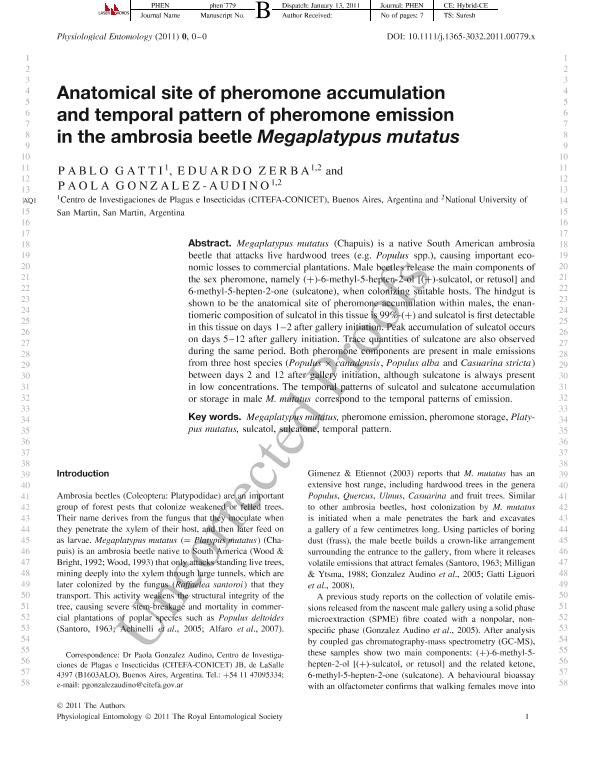Mostrar el registro sencillo del ítem
dc.contributor.author
Gatti, Pablo
dc.contributor.author
Zerba, Eduardo Nicolás

dc.contributor.author
Gonzalez Audino, Paola Andrea

dc.date.available
2019-08-21T22:01:31Z
dc.date.issued
2011-09
dc.identifier.citation
Gatti, Pablo; Zerba, Eduardo Nicolás; Gonzalez Audino, Paola Andrea; Anatomical site of pheromone accumulation and temporal pattern of pheromone emission in the ambrosia beetle Megaplatypus mutatus; Wiley Blackwell Publishing, Inc; Physiological Entomology (print); 36; 3; 9-2011; 201-207
dc.identifier.issn
0307-6962
dc.identifier.uri
http://hdl.handle.net/11336/81941
dc.description.abstract
Megaplatypus mutatus (Chapuis) is a native South American ambrosia beetle that attacks live hardwood trees (e.g. Populus spp.), causing important economic losses to commercial plantations. Male beetles release the main components of the sex pheromone, namely (+)-6-methyl-5-hepten-2-ol [(+)-sulcatol, or retusol] and 6-methyl-5-hepten-2-one (sulcatone), when colonizing suitable hosts. The hindgut is shown to be the anatomical site of pheromone accumulation within males, the enantiomeric composition of sulcatol in this tissue is 99%-(+) and sulcatol is first detectable in this tissue on days 1-2 after gallery initiation. Peak accumulation of sulcatol occurs on days 5-12 after gallery initiation. Trace quantities of sulcatone are also observed during the same period. Both pheromone components are present in male emissions from three host species (Populus×canadensis, Populus alba and Casuarina stricta) between days 2 and 12 after gallery initiation, although sulcatone is always present in low concentrations. The temporal patterns of sulcatol and sulcatone accumulation or storage in male M. mutatus correspond to the temporal patterns of emission.
dc.format
application/pdf
dc.language.iso
eng
dc.publisher
Wiley Blackwell Publishing, Inc

dc.rights
info:eu-repo/semantics/openAccess
dc.rights.uri
https://creativecommons.org/licenses/by-nc-sa/2.5/ar/
dc.subject
Megaplatypus Mutatus
dc.subject
Pheromone Emission
dc.subject
Pheromone Storage
dc.subject
Platypus Mutatus
dc.subject
Sulcatol
dc.subject
Sulcatone
dc.subject
Temporal Pattern
dc.subject.classification
Otras Ciencias Químicas

dc.subject.classification
Ciencias Químicas

dc.subject.classification
CIENCIAS NATURALES Y EXACTAS

dc.title
Anatomical site of pheromone accumulation and temporal pattern of pheromone emission in the ambrosia beetle Megaplatypus mutatus
dc.type
info:eu-repo/semantics/article
dc.type
info:ar-repo/semantics/artículo
dc.type
info:eu-repo/semantics/publishedVersion
dc.date.updated
2019-08-21T13:49:07Z
dc.journal.volume
36
dc.journal.number
3
dc.journal.pagination
201-207
dc.journal.pais
Reino Unido

dc.journal.ciudad
Londres
dc.description.fil
Fil: Gatti, Pablo. Consejo Nacional de Investigaciones Científicas y Técnicas. Instituto de Investigaciones Científicas y Técnicas para la Defensa. Centro de Investigación de Plagas e Insecticidas; Argentina
dc.description.fil
Fil: Zerba, Eduardo Nicolás. Consejo Nacional de Investigaciones Científicas y Técnicas. Instituto de Investigaciones Científicas y Técnicas para la Defensa. Centro de Investigación de Plagas e Insecticidas; Argentina. Universidad Nacional de San Martín; Argentina
dc.description.fil
Fil: Gonzalez Audino, Paola Andrea. Consejo Nacional de Investigaciones Científicas y Técnicas. Instituto de Investigaciones Científicas y Técnicas para la Defensa. Centro de Investigación de Plagas e Insecticidas; Argentina. Universidad Nacional de San Martín; Argentina
dc.journal.title
Physiological Entomology (print)

dc.relation.alternativeid
info:eu-repo/semantics/altIdentifier/url/https://onlinelibrary.wiley.com/doi/abs/10.1111/j.1365-3032.2011.00779.x
dc.relation.alternativeid
info:eu-repo/semantics/altIdentifier/doi/https://doi.org/10.1111/j.1365-3032.2011.00779.x
Archivos asociados
